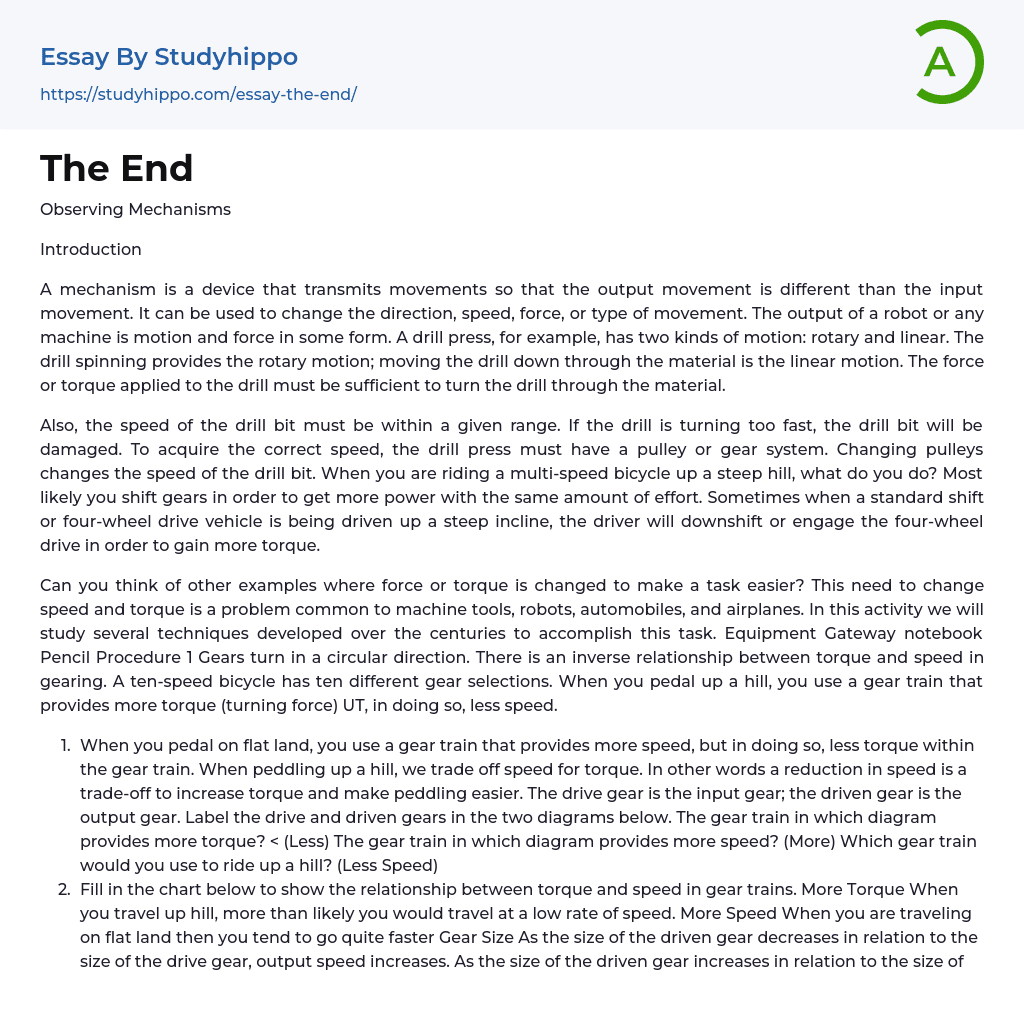Observing Mechanisms
Introduction
A mechanism is a device that transmits movements so that the output movement is different than the input movement. It can be used to change the direction, speed, force, or type of movement. The output of a robot or any machine is motion and force in some form. A drill press, for example, has two kinds of motion: rotary and linear. The drill spinning provides the rotary motion; moving the drill down through the material is the linear motion. The force or torque applied to the drill must be sufficient to turn the drill through the material.
Also, the speed of the drill bit must be within a given range. If the drill is turning too fast, the drill bit will be damaged. To acquire the correct speed, th
...e drill press must have a pulley or gear system. Changing pulleys changes the speed of the drill bit. When you are riding a multi-speed bicycle up a steep hill, what do you do? Most likely you shift gears in order to get more power with the same amount of effort. Sometimes when a standard shift or four-wheel drive vehicle is being driven up a steep incline, the driver will downshift or engage the four-wheel drive in order to gain more torque.
Can you think of other examples where force or torque is changed to make a task easier? This need to change speed and torque is a problem common to machine tools, robots, automobiles, and airplanes. In this activity we will study several techniques developed over the centuries to accomplish this task. Equipment Gateway notebook Pencil Procedure 1 Gears turn in
circular direction. There is an inverse relationship between torque and speed in gearing. A ten-speed bicycle has ten different gear selections. When you pedal up a hill, you use a gear train that provides more torque (turning force) UT, in doing so, less speed.
- When you pedal on flat land, you use a gear train that provides more speed, but in doing so, less torque within the gear train. When peddling up a hill, we trade off speed for torque. In other words a reduction in speed is a trade-off to increase torque and make peddling easier. The drive gear is the input gear; the driven gear is the output gear. Label the drive and driven gears in the two diagrams below. The gear train in which diagram provides more torque? < (Less) The gear train in which diagram provides more speed? (More) Which gear train would you use to ride up a hill? (Less Speed)
- Fill in the chart below to show the relationship between torque and speed in gear trains. More Torque When you travel up hill, more than likely you would travel at a low rate of speed. More Speed When you are traveling on flat land then you tend to go quite faster Gear Size As the size of the driven gear decreases in relation to the size of the drive gear, output speed increases. As the size of the driven gear increases in relation to the size of the drive gear, output torque increases.
- Complete the chart below. Show the relationship between drive gear and driven gear in a simple gear train. Driven Gear Size To Increase Torque The gear
size would be at the Max. To Increase Speed The gear size would be at the lowest
Big Wheel
I think it would be the same as the Small Wheel, I think this because they look they are the same but one is bigger than another. Gears I think the gears would stay the same speed because usually gears go the same speed. Also the force would be the same because Gears are pretty Strong. Man Pulling String The man pulling the string would have the same speed until he got tired the he would need to apply more
and more speed. He would be in the same direction because all he is doing is pulling string that is connected to a huge wheel, so you would have to pull in the same direction.
Woman pulling the Bell The woman would have different speed every time she pulls the string to the bell, because it depends on if she's late on pulling the bell and she has to pull as fast as she can. The woman taping the thing As I said like she was pulling the bell her speed would be at different rates because she is applying more force or less force each time.
Conclusion
Label the input and output for each of the pictures shown below. Then write the type of movement for each. Input- Output- This input would a Rotary. This would be a Rotary also. This would be Oscillating. This would be a Rotary.
- Classical Mechanics essays
- Rail Transport essays
- Tata Motors essays
- Vehicle Brands essays
- trucks essays
- Auto Racing essays
- Harley-Davidson essays
- Suzuki essays
- Lexus essays
- Mercedes-Benz essays
- Automotive essays
- Automotive Industry essays
- Commerce essays
- Construction essays
- E Commerce essays
- Grocery stores essays
- Paper Industry essays
- Pharmaceutical industry essays
- Pharmacy essays
- Polymers essays
- Real Estate essays
- Textile Industry essays
- Atom essays
- Big Bang Theory essays
- Density essays
- Electricity essays
- Energy essays
- Force essays
- Heat essays
- Light essays
- Motion essays
- Nuclear Power essays
- Physiology essays
- Sound essays
- Speed essays
- Temperature essays
- Thermodynamics essays
- Automobile essays
- Bus essays
- Civil engineering essays
- Cycling essays
- Electric Car essays
- Genetic Engineering essays
- Hybrid essays
- Innovation essays
- Internal Combustion Engine essays
- Invention essays
- Mechanical Engineering essays
- Mechanics essays
- Software Engineering essays




